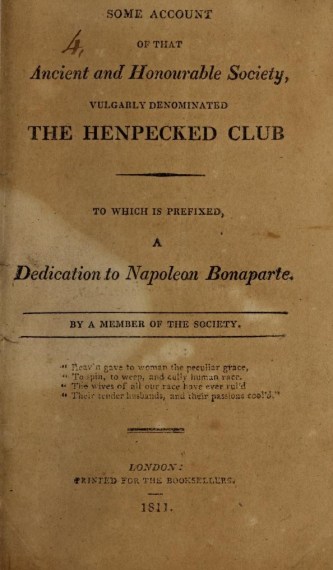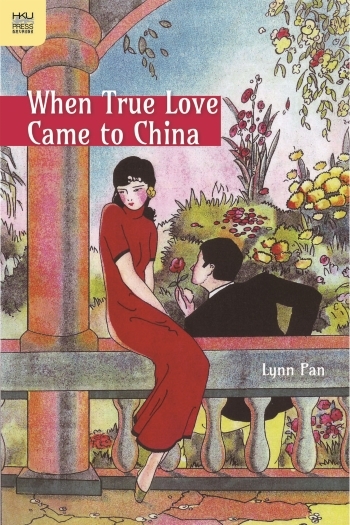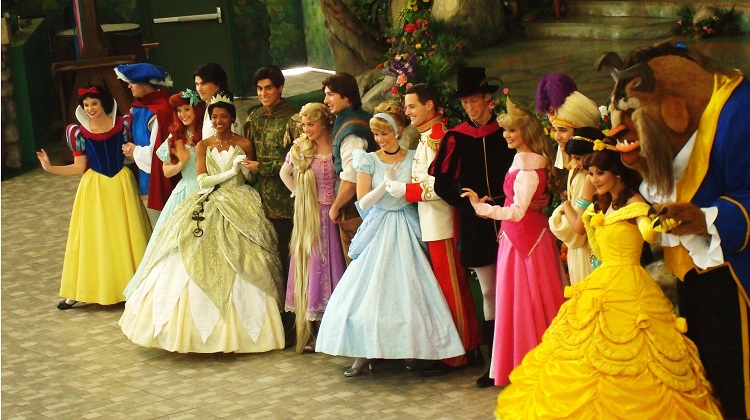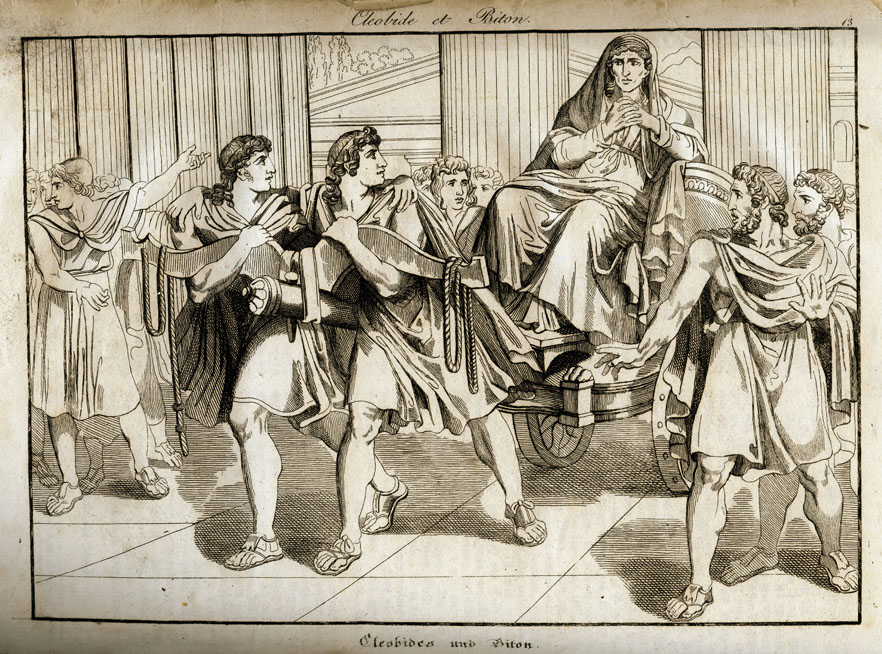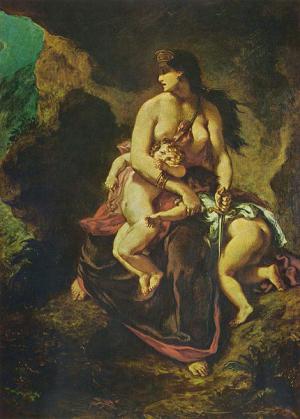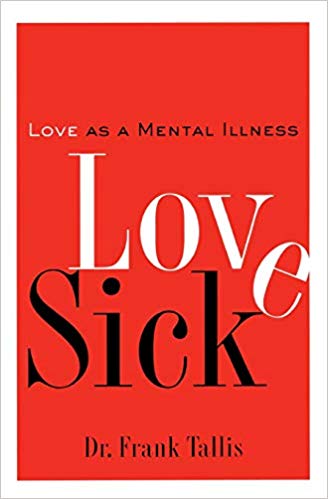Lo que viene a continuación es una versión ampliada de un artículo de 2014. —PW
Muchos hombres buenos del Club de los Calzonazos deben mostrar buen comportamiento para poder mantener una relación pacífica con su media naranja —(1860)1
El Club de los Calzonazos es una organización absolutamente real, de alcance mundial, que lleva funcionando de manera continuada durante al menos 200 años. Atendía las necesidades de los hombres casados que sufrían maltrato doméstico por parte de sus esposas, y también atendía a jóvenes solteros que más adelante, tras casarse, quizá tuvieran que enfrentarse a los mismos problemas.
El Club de los Calzonazos (básicamente un proyecto para crear “buenos hombres” consistía en una red internacional de lugares de encuentro a los que acudían los hombres en busca de apoyo, especialmente si estaban sufriendo maltrato emocional y físico por parte de sus esposas. En este sentido, el club es similar a Al-Anon, el movimiento moderno de apoyo a cónyuges de alcohólicos. Estos clubs animaban activamente a los maridos a que tolerasenel maltrato de sus mujeres, y su estrategia consistía en aplacarlas con el medio que fuese necesario para moderar los comportamientos abus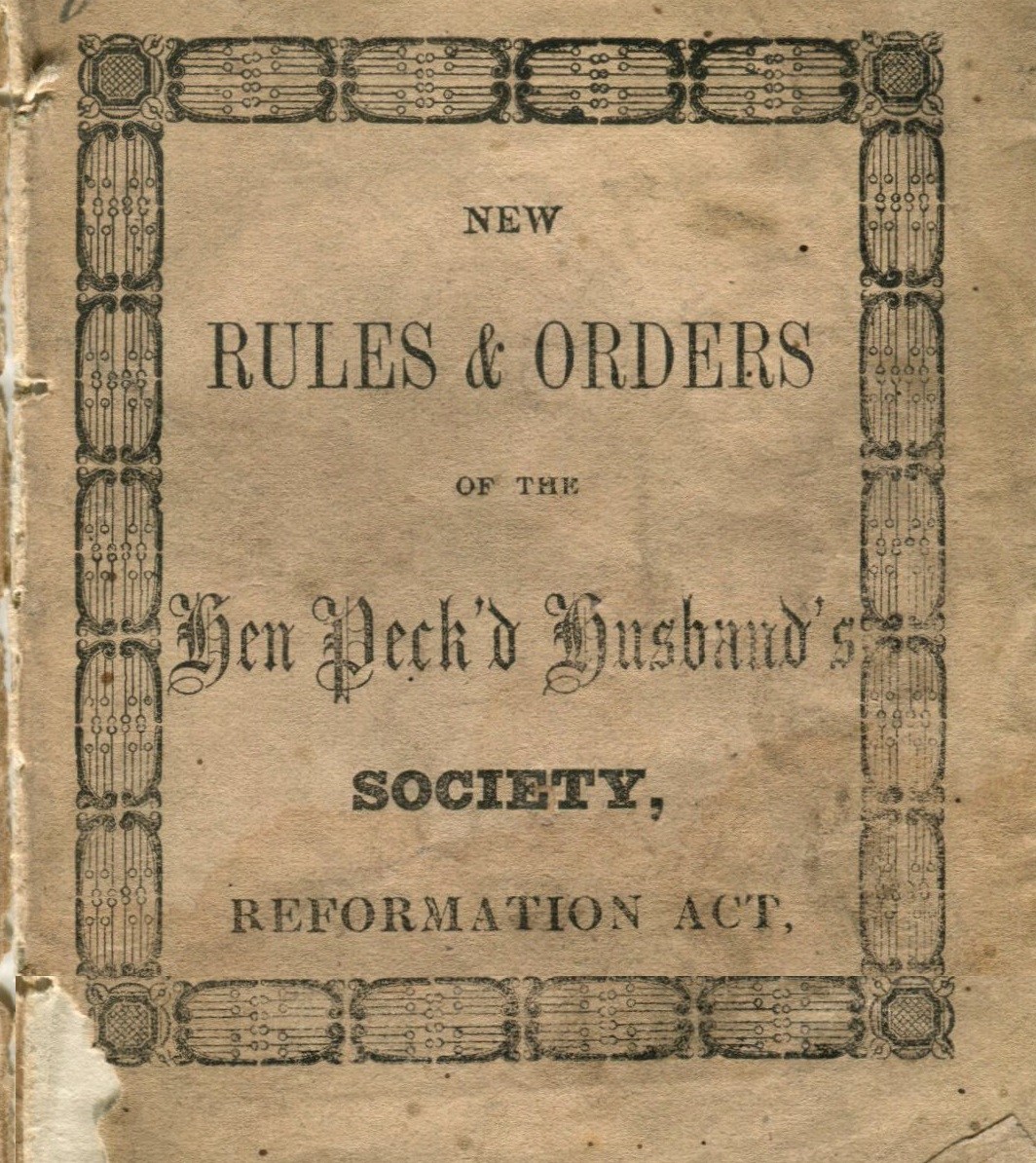 ivos.
ivos.
La palabra clave aquí es “aplacar”, que es algo que los hombres hacían sobradamente.
Se esperaba que los miembros del Club de los Calzonazos, por ejemplo, les llevaran el desayuno a la cama a sus esposas a diario, y que hicieran la mayoría de las tareas domésticas, incluso después de un duro día de trabajo, con la esperanza de conseguir que sus mujeres mantuvieran un humor más afable o (más exactamente) menos abusivo. A continuación se recogen instrucciones a todos los miembros del club:
- Que todo miembro de esta sociedad encienda el fuego, prepare la tetera y haga hervir agua antes de despertar a su esposa por la mañana.
- Que todo miembro le lleve a su esposa la ropa a la cama, tras haberla aireado y calentado, o recibirá una multa de dos peniques por cada falta.
- Que le contará a su esposa el trabajo que ha llevado a cabo, y le preguntará si desea que haga algo más antes de irse a trabajar esa mañana.
- Que si algún miembro llega a casa para la cena y se encuentra a su esposa chismorreando, y la cena sin hacer, no se quejará, sino que cocinará para sí mismo y para su familia, además de algo que le guste a su esposa para cuando esta vuelva a casa, o recibirá una multa de tres peniques.
- Que si algún miembro, tras la jornada de trabajo, llega a casa y descubre que su mujer no ha lavado la vajilla, o alguna otra cosa que considera que debería haber hecho, debe hacerlo él mismo y no criticarla; igualmente, debe atender el fuego, calentar agua, barrer la casa, fregar el suelo y hacer las camas al gusto de ella, o recibirá una multa de cuatro peniques.
- Que cuando algún miembro haya finalizado su semana laboral, deberá volver a casa con su salario y entregárselo íntegramente a su esposa.
- Que cuando algún miembro haya entregado su salario a su esposa, le preguntará qué desea que haga a continuación; si desea que vaya a la tienda, deberá ir, pero si desea ir ella misma, deberá quedarse y limpiar la casa y los muebles, y ordenarlo todo de manera que ella esté contenta cuando vuelva, o recibirá una multa de seis peniques.
- Que todas las mañanas de domingo, los miembros se levantarán a las seis de la mañana, encenderán el fuego, lavarán y vestirán a los niños (si los tienen) y los prepararán para el colegio, sin tener que molestar a su amada esposa; pero si ella le pide una pipa de tabaco, polvo de rapé o un refresco, deberá dárselo inmediatamente, o recibirá una multa de seis peniques.
- Que si por ventura la esposa de un miembro desea tener prendas de calidad, como un sombrero de terciopelo de seda, un fino gorro con flores artificiales, un vestido nuevo, un miriñaque, botas, sandalias, medias de seda o cualquier otra prenda de moda, su marido deberá proporcionárselas, empleando para ello el dinero de sus horas extra, o recibirá una multa de un chelín y ocho peniques.
- Que cuando la esposa de un miembro esté enferma o de parto, deberá correr tan rápido como pueda en busca del médico, ya sea de día o de noche, con nieve o con escarcha, granizo o lluvia, o recibirá una multa de dos chelines.
- Que cualquier miembro que se niegue a lavar al niño cuando haya hecho de vientre o defecado, recibirá una multa de seis peniques.
- Que todos los miembros deberán lavar los pañales sucios del niño cuando su esposa se lo ordene, o recibirá una multa de cuatro peniques.
- Que todos los lunes por la noche, los miembros deberán lustrar los zapatos y los zuecos de su esposa y sus hijos.
- Que todos los martes por la noche, los miembros deberán ir a buscar la ropa para lavar.
- Que todos los miércoles por la noche, los miembros deberán revisar la bodega y comprobar que hay suficiente té, café, azúcar, mantequilla, pan, queso, harina, harina de maíz, carne de ternera o de carnero, y si resulta que falta algo, deberá ir a comprar más sin quejarse.
- Que todos los jueves por la noche, los miembros deberán proporcionar a sus queridas esposas aquello que, según las circunstancias, pueda mejorar su felicidad íntima, como refrescos o licores.
- Que todos los viernes por la noche, los miembros deberán revisar las medias, camisas, etc., que necesiten un remiendo, y deberá remendarlas él mismo.
- Que todos los miembros deberán cumplir religiosamente las últimas cinco normas, o recibirán una multa de tres peniques por cada negligencia, impuesta por el comité2.
A veces, los miembros que sufrían maltrato a manos de sus esposas disfrazaban estas instrucciones(habituales en la mayoría de los Clubes de los Calzonazos)con humor y burlas hacia sí mismos. Esto ha llevado a concluir, erróneamente, que estos clubes eran una mera comedia. Pero se trata de una suposición incorrecta, tal vez fomentada por el rechazo a la idea de la violencia femenina: el problema del maltrato doméstico era una preocupación grave para los clubes, como también lo eran las estrategias para enfrentarse a ella.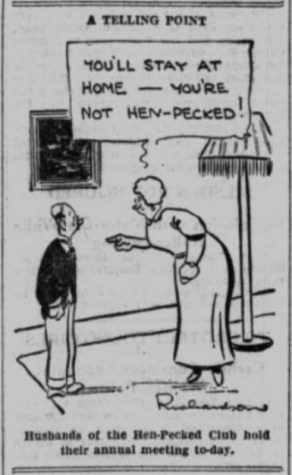
También se recomendaba a los hombres que absorbiesen cualquier violencia o maltrato sin quejarse, tolerándola estoicamente para no provocar ni irritar más a la maltratadora. La política del club explicaba que así era como uno se convertía en un “buen hombre”. Si la esposa del hombre continuaba con su maltrato tras estos gestos conciliadores, los oficiales del club preguntaban al hombre qué podía haber hecho inconscientemente para provocarla; también le preguntaban cómo podía servirla mejor para que no volviera a irritarse. La respuesta a esa pregunta solía ser que el hombre hiciera más tareas domésticas, aunque también existía una intervención innovadora: “acunar a la esposa hasta que se durmiera”; hablaré de esto más adelante.
Los clubes de los calzonazos existieron a centenares desde el siglo XVIII hasta la época contemporánea, y en lugares tan diversos como Inglaterra, Austria, Estados Unidos, Alemania, Francia, Australia, Yugoslavia, China y Japón.
¿Por qué, en una época en la que estamos tan centrados en las relaciones de género, no hemos oído hablar de estos clubes, teniendo en cuenta que en muchos había cientos de miembros esforzándose por sobrellevar matrimonios difíciles? Ni una mención de los historiadores, a pesar de la disponibilidad de materiales sobre los Clubes de los calzonazos. ¿Por qué?
Porque no pega con la imagen del “marido patriarcal dominante” que presentan las interpretaciones históricas modernas.
Así que con la intención de corregir la historia, a continuación presentamos un breve fragmento de un libro de 1810, titulado Descripción de una antigua y honorable sociedad, vulgarmente conocida como El club de los calzonazos, que demuestra que el proyecto de creación de “hombres buenos” lleva existiendo al menos 200 años, y probablemente aún más tiempo:
“[Los maridos] se someten a la agradable esclavitud de sus esposas en tan gran número, y con tanta buena voluntad, como en cualquier otro período ilustrado de la historia antigua o moderna.”
“El calzonismo, que cuenta en sus filas con la mayor parte de los hombres más célebres que han nacido desde la creación hasta el día de hoy, ya sean legisladores, filósofos, conquistadores, poetas y enviados de Dios, no requiere otro argumento para justificar y establecer su derecho a influir y actuar de manera extensiva, que el lenguaje de todo amante, que admite sin reparos ser (y jura seguir siendo) el esclavo de su querida, antes del matrimonio; por lo tanto, aquel que niega la supremacía de la mujer que se convierte en su esposa es culpable de una rebelión criminal y antinatural contra la autoridad de la mujer, que el mismo Dios le ha impuesto al hombre. Sin embargo, si se quieren conocer otros argumentos, podrían aportarse muchos que demuestren que la superioridad de la hembra es de orden natural. Por ejemplo, tanto el más noble como el más fiero de los perros se someten dócilmente a los gruñidos y ladridos de la perra más lastimera de su especie.”
“Porque en el calzonismo no se hacen distinciones: la mujer sin igual mandonea a su vasallo tanto como la campesina: a todas se aplica por igual la feliz descripción del poeta:
“El vasallo encorvado de la esposa tirana,
Que no posee ni un céntimo que no le pertenezca a ella,
Que no tiene voluntad más que si ella se digna a dársela,
Que debe contarle los secretos de sus mejores amigos,
Que teme más que a nada una bronca a puerta cerrada.”
“Las normas que acatan los miembros de esas reuniones estaban en todo punto adaptadas para preservar la existencia de la institución. Los miembros que tuviesen el honor de recibir un ojo morado de su cónyuge tenían derecho a una asignación de 10 chelines con 6 peniques, mientras ese glorioso color perdurase. La asignación por los dos ojos morados era de un libra y un chelín. En cualquier caso, era necesario aportar pruebas de que la contusión había sido adquirida de acuerdo al verdadero espíritu del auténtico calzonismo, es decir, sin resistencia ni murmuración, según el ejemplo de nuestro inestimable miembro fallecido, Sócrates, al cual, junto a su esposa, alude el poeta en las siguientes líneas:
“Él sabía cuán a menudo ella lo regañaba,
Cuántos orinales le arrojaba al sabio,
Quien con paciencia se secaba la cabeza,
Y repetía: la lluvia sigue a los truenos.”
Los hombres casados que no tuvieran el honor de pertenecer a la Sociedad, eran sinceramente invitados a asistir a estas reuniones, no en calidad de miembros, sino de visitantes, para que pudieran convencerlos para unirse al ser testigos de la absoluta felicidad que esta otorga. Porque, ¿qué felicidad puede ser mayor que la de pertenecer a una esposa que se ocupa de la pesada carga de regular no sólo su conducta, sino también la de su marido y la del resto de su familia; a una esposa que se toma la molestia de recibir y gestionar todo el dinero; a una esposa que amablemente lleva a cabo la tarea de juzgar en nombre de su marido (en todos los casos) lo que debe hacer; cuánto tiempo debe pasar en el bar; cuánto dinero debe gastar; qué secretos debe guardar (ella, en realidad) y cuáles deben ser divulgados? En resumen, una mujer que carga sobre sus espaldas toda la ansiedad, todos los problemas, dejándole a su querido esposo la única y agradable tarea de ejecutar sus órdenes; recordemos que:
“Su propio cuerpo no es de él, sino mío,
Porque así lo dijo Pablo, y Pablo es un gran enviado de Dios.”
“El plan y el objeto evidente de la institución siempre ha sido preservar y, si es posible, ampliar el justo y loable dominio del bello sexo. Por ello, en las distintas reuniones se consideró adecuado solicitar también la asistencia de hombres solteros, no sólo para que se beneficien de tan perfectos ejemplos de sumisión, sino para que los solteros que aún no hayan pensado en el matrimonio, o que no hayan reparado en un aliciente para casarse tan importante como la existencia de nuestra institución, sean persuadidos de la conveniencia de colocarse, tan pronto como sea posible, a la altura de la mayor parte de los grandes hombres del mundo, a este respecto.”
“Los métodos más habituales que utilizan las hembras para intentar ejercer por completo ese poder ilimitado que les pertenece por derecho, consisten en, poco tiempo después del matrimonio, volverse extremadamente ruidosas y agresivas, y asegurarse de reprender a sus maridos por cualquier acción que realicen, crean o no sinceramente que su conducta ha sido censurable. Este método a veces se acompaña de golpes físicos. Si se continúa este comportamiento con perseverancia y energía, lo más probable es que se tenga éxito, pero existe un peligro considerable de resistencia por parte de individuos brutales imprudentemente denominados hombres de espíritu; esa resistencia puede acompañarse de consecuencias extremadamente perjudiciales para el semblante femenino. Sin embargo, recomendaría rotundamente a las mujeres que empleen este método con aquellos caracteres afeminados que tienen más miedo a recibir una paliza que disposición a defender su título de hombría, y considero especialmente apropiada su práctica con todos los petimetres y lechuguinos, criaturas que no poseen mayor prueba de su estatus de hombre que el hecho de tener dos piernas y vestir pantalones.”
“Ciertas mujeres siguen el rumbo contrario, con mucho éxito. En un momento dado cubren a sus maridos de caricias, exageran su propio afecto, y parecen no tener otro pasatiempo que convencerlos de que el único objetivo de sus vidas será inventar nuevos halagos, y hacerlos absolutamente felices en todos los aspectos. Sin embargo, en otro momento afectan enfado: una melancolía repentina y huraña sustituye su alegría anterior; suspiran con frecuencia, y rompen a llorar; además, sufren desvanecimientos y ataques de histeria.”
El desdichado marido de semejante esposa, alarmado por estos sorprendentes síntomas, le pregunta con ansiedad por el motivo. Ella finge evadir la pregunta; él se vuelve más insistente; ella insiste en su negativa a darle un motivo; su importunidad se acrecienta; hasta que al final le dice, con un gentil reproche y un estallido de dolor, que él le está rompiendo el corazón, que la única recompensa de su amor es el abandono, etc., etc. Asombrado por unas acusaciones que no cree merecer, al principio se esfuerza por ridiculizar lo que denomina ansiedad infantil. Sin embargo, ella finge seguir dudando; él protesta solemnemente, declarando su inocencia; y ambos se reconcilian. No obstante, en unos días se representa la misma farsa una y otra vez, hasta que el hombre infeliz se convence, en contra de lo que le dicen sus propios sentidos, de que su comportamiento ha sido inmoral. Es más, para aplacar a su afligida compañera, acaba por confesar sus faltas imaginarias, y promete corregirse en adelante. Por miedo a ofenderla involuntariamente, aprende a vigilar estrechamente sus propias acciones, tiene miedo a fijarse en las acciones de su esposa y, por el mismo motivo, es muy cauto a la hora de contradecirla, no sea que su crueldad le provoque un desvanecimiento; en resumen, se convierte en miembro de la Sociedad de los Calzonazos.
“Aunque el objetivo principal de nuestra sociedad es expandir la dominación del sexo femenino, no queremos en absoluto alcanzar ese fin con medios reprobables o inadecuados. Los únicos miembros dignos de la Sociedad son aquellos que lo son por estar convencidos de que serlo es algo útil, además de por un adecuado sentido de la superioridad de sus esposas. Sin embargo, todos esos miembros han sido tratados de una forma muy distinta a la que hemos descrito. Primero se han visto obligados a reconocer (y que todas las esposas se esfuercen por hacer lo mismo) que sus esposas, gracias a su cuidado y su frugalidad, están mejor adaptadas que ellos mismos para encargarse de sus preocupaciones; gracias a su comportamiento atento, que están mejor dotadas para gobernar sobre la familia; gracias a su benevolencia y moderación, que nunca abusarán de la autoridad que se les confiera. En un núcleo familiar así, jamás habrá conatos de resistencia. Las órdenes de una de las partes serán cumplidas con diligencia por la otra. Se establecerá una perpetua armonía; y las correcciones, cuando sean necesarias, se acatarán según la norma fundamental de la Sociedad, sin murmuración y sin resistencia alguna.”3
El pacificador de esposas del Buen Hombre

Caja de paz del club de los calzonazos —Cura evidente para una esposa enfadada
Los buenos hombres del Club de los Calzonazos fueron responsables de un invento interesante: una cuna para adultos, que se empleaba para relajar a las esposas irritadas en vez de a los bebés. Si os fijáis veréis que tienen un pie curvado para que el solícito marido la pueda mecer suavemente de lado a lado.
La “Caja de paz” fue inventada en 1862 por un miembro del club llamado Harry Tap, y los miembros del Club de los Calzonazos que sufrían el comportamiento tempestuoso de sus esposas podían alquilarlas. Si una esposa maltrataba demasiado a su marido, el marido le pedía a su esposa que se acostase en la caja, que podía mecerse como la cuna de un niño, para conseguir que la esposa se durmiera. Mientras ella dormía, el marido realizaba todas las tareas del hogar, y después despertaba a su esposa, que con suerte ya se habría calmado.
Ahora que estos jugosos datos históricos salen a la luz, parece que hemos cerrado el círculo; regreso al futuro. Aquí seguimos, con el sombrero en la mano, suplicando perdón a la Querida Mujer por haberla disgustado, esperando que se dé cuenta de lo mucho que estamos intentando ser hombres buenos.
Puede que a estas alturas sientas náuseas al saber que los hombres han estado arrastrándose ante semejante maltrato durante cientos de años, o puede que miles, y aun así se nos sigue exigiendo que Lo encajes como un hombre™, Seas un hombre™, y que Seas un buen hombre™. Si te sientes así, no estás solo, y con el creciente ejército de hombres y mujeres del Movimiento por los Derechos del Hombre, puedes contribuir a acabar con unas costumbres ginocéntricas tan nefastas.
FUENTES:
[1] Huddersfield Chronicle – Sábado 11 de agosto de 1860
[2] Esta lista de deberes se utilizaba en la división de Rochdale del club, y es una versión resumida de un documento oficial anterior que circulaba por los clubes: Acta de mejora de nuevas normas y órdenes (1840).
[3] Descripción de una antigua y honorable sociedad, vulgarmente conocida como El club de los calzonazos(1810).
